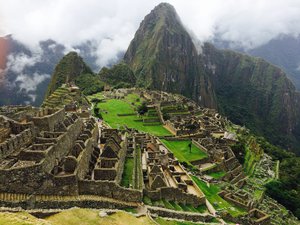Advertisement
Published: March 12th 2015

 Machu Picchu
Machu Picchu
The iconic view of "the Lost City of the Incas"I realize that my last blog was relatively short and may have appeared somewhat frazzled. Here are some more details from our time in Cusco.
Cusco is "The Cultural Capital of the World" and has a very old feel. It's nestled in the mountains, there are no skyscrapers, and all of the narrow streets and sidewalks are cobblestone. One reference I checked said the population is around 420,000 and the elevation is around 11,500 ft. Because of its history and proximity to Machu Picchu and other Incan ruins, Cusco is very touristy. We stayed at a hostel not far from the edge of town. The hostel is converted from a 250 year old building and has a beautiful open-air courtyard in the middle with tables, a pool table, a fountain, and a small kitchen under a canopy. The ceilings are vaulted with the original log beams for rafters, and thick (up to 2 meters) walls made of earth and stucco-like material. The roof of this hostel, like almost every other building in town, is composed of Spanish-style clay tiles.
A Comedy of Errors So we did end up making it to Machu Picchu, by some stroke of luck.
The night before our excursion, we made hurried plans, including purchasing last-minute bus and train tickets. We woke up at 4:30 and left Cusco via a bus around 5:20. The 2 hour bus ride connected with a 2 hour train ride through the Andes. The mountains were spectacular. PeruRail operated the train and made even us poor med students feel like royalty by providing us with a small meal, complete with table cloths and a centerpiece. The real fun began when we got to the base of Machu Picchu. So the "city" of Macchu Picchu is a large section of ruins built by the Incas in the 1400s as a mountain retreat. There is the mountain of Machu Picchu in front of it, and the mountain of Huayna Picchu behind it (Huayna Picchu is the peak visible in most of the iconic pictures.) This place wasn't discovered by the outside world until 1911 when Hiram Bingham, a Yale archaeologist, located it with the help of local Andean farmers.
Anyways, back to our traveling woes. We arrived at the base of the mountain and had a heck of a time purchasing admission tickets. We then had to purchase bus tickets
to drive us the few miles up the mountain. We purchased an admission ticket that allowed us to climb the actual mountain of Machu Picchu, but you have to start the ascent by 11:00 am, and it just so happened that our bus arrived at the trailhead at 10:49. Imagine, if you will, 3 young men who live at about 600 ft elevation that are suddenly brought to about 8,000 ft and forced to run between 0.25 and 0.5 miles in less than 11 minutes steeply uphill in order to make it to the gate before it closes. We made it with 2 minutes to spare. But it was still an hour or more hike and 2000 ft up to the top. Never in my life, even when I climbed Pike's Peak or ran the Chicago Marathon, have I felt so short of breath.
The view of Machu Picchu was fantastic. It is one of those things, like the Grand Canyon, that you just cannot describe nor can you fully capture its magnitude in any photograph.We spent many hours exploring the ruins, taking selfies with llamas, and taking in the beauty of the city and the surrounding Andes mountains.
This place is honestly one of the most overwhelmingly breathtaking places I have ever seen in my life.
We made it back to Cusco about four hours later. The day after we flew back to Lima, but that is a tale for another time.
Cultural notes:
Traffic: it's crazy. Small cars weave across the streets and are CONSTANTLY honking their horns. There are very few traffic lights in the city, so drivers communicate by honking, more or less. Pedestrians never really have the right of way, so that keeps you on your toes.
Dogs: they're everywhere. I've never seen so many dogs in my life. I'm not talking about people taking their pooch for a walk, I'm talking about canines of every size and color wandering freely. I've seen dogs sleeping on church steps, standing on top of full dumpsters, successfully dodging traffic, and traveling in packs outside the city. These dogs don't seem to take much notice of humans and don't bother us or beg for food.
Money: most things are cheap. A 10 minute taxi ride for 4 people costs only 5 soles (about $1.60 USD), alpaca sweaters are only about
35 soles, and a full meal at the market is less than 6 soles. Some of the tourist stuff is more expensive, but I suppose that is understandable.
Markets: there are some typical supermarkets here like in the US, and there are more small "mom and pop's" type markets along the road, but the best is the large mercados (markets) in the middle of town. There are people selling almost everything you could imagine. Need a box of thumbtacks? It just so happens there is a guy on the street selling them. How about the entire snout of a cow? Look no further than the meat section of the city mercado. Now you may be thinking to yourself, "Surely you don't mean EVERYTHING. I bet I you couldn't buy a 2 liter plastic bottle filled with snakes in a brine," in which case you would be incorrect - because I saw exactly that at the market.
Advertisement
Tot: 0.08s; Tpl: 0.012s; cc: 7; qc: 46; dbt: 0.0452s; 1; m:domysql w:travelblog (10.17.0.13); sld: 1;
; mem: 1.1mb
























Mike Nay
non-member comment
psh
Montana? I thought you were in South America... 3082 feet? That's nothin